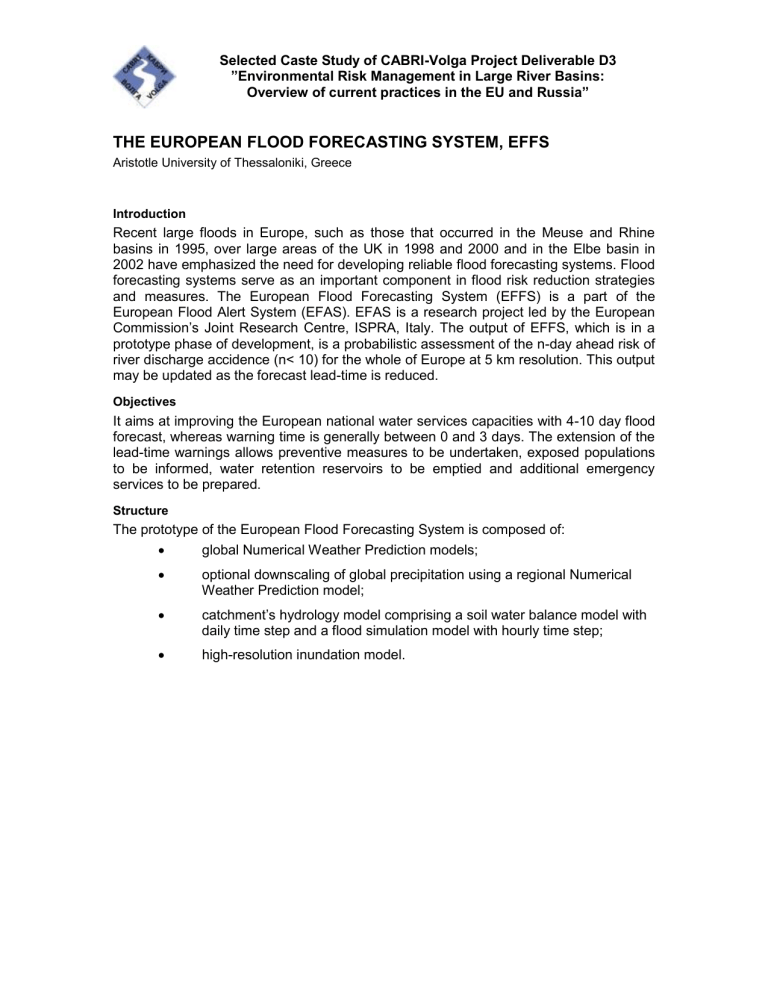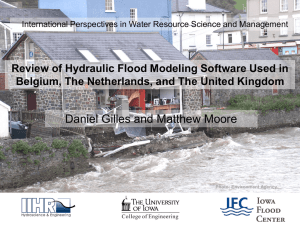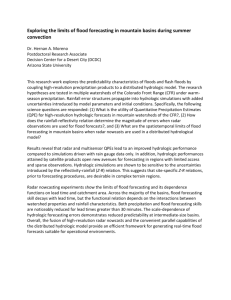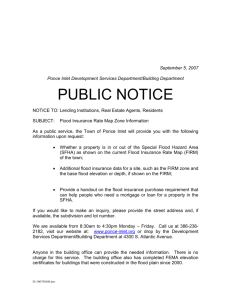THE EUROPEAN FLOOD FORECASTING SYSTEM, EFFS

Selected Caste Study of CABRI-Volga Project Deliverable D3
”Environmental Risk Management in Large River Basins:
Overview of current practices in the EU and Russia”
THE EUROPEAN FLOOD FORECASTING SYSTEM, EFFS
Aristotle University of Thessaloniki, Greece
Introduction
Recent large floods in Europe, such as those that occurred in the Meuse and Rhine basins in 1995, over large areas of the UK in 1998 and 2000 and in the Elbe basin in
2002 have emphasized the need for developing reliable flood forecasting systems. Flood forecasting systems serve as an important component in flood risk reduction strategies and measures. The European Flood Forecasting System (EFFS) is a part of the
European Flood Alert System (EFAS). EFAS is a research project led by the European
Commission’s Joint Research Centre, ISPRA, Italy. The output of EFFS, which is in a prototype phase of development, is a probabilistic assessment of the n-day ahead risk of river discharge accidence (n< 10) for the whole of Europe at 5 km resolution. This output may be updated as the forecast lead-time is reduced.
Objectives
It aims at improving the European national water services capacities with 4-10 day flood forecast, whereas warning time is generally between 0 and 3 days. The extension of the lead-time warnings allows preventive measures to be undertaken, exposed populations to be informed, water retention reservoirs to be emptied and additional emergency services to be prepared.
Structure
The prototype of the European Flood Forecasting System is composed of:
global Numerical Weather Prediction models;
optional downscaling of global precipitation using a regional Numerical
Weather Prediction model;
catchment’s hydrology model comprising a soil water balance model with daily time step and a flood simulation model with hourly time step;
high-resolution inundation model.
Selected Caste Study of CABRI-Volga Project Deliverable D3
”Environmental Risk Management in Large River Basins:
Overview of current practices in the EU and Russia”
Numerical weather prediction models
The equations expressing the mass, momentum and energy balance are solved every
15 minutes. The atmosphere is divided into 60 layers up to 0.1 HPa (64 km). The horizontal resolution is about 40 km for deterministic forecasts and 80km for probabilistic ones, with a lead time of up to 10 days.
Catchment hydrology models
The default model used in the EFFS system is LISFLOOD. LISFLOOD is a physical based catchment model, especially developed for the European river basins. It is a rainfall-runoff model that takes into account the influence of topography, precipitation amounts and intensities, antecedent soil moisture, land use type and soil type.
Physical processes such as interception of rainfall by vegetation, evapo-transpiration, snowmelt, infiltration and capillary drive are simulated, and it is shown in the figure below.
Selected Caste Study of CABRI-Volga Project Deliverable D3
”Environmental Risk Management in Large River Basins:
Overview of current practices in the EU and Russia”
Fig. 12: Physical processes simulated in the LISFLOOD model.
Application to the 1995 Meuse River flood
At the beginning of 1995, most European river basins had been hit by floods, especially the Meuse River which experienced a rare event with discharge up to 3000 m3/s. By comparing the result of the modelling and the measured past events the validation of the flood forecasting system should be possible.
The simulation of this event was developed in two steps:
The water balance model was first run and calibrated for the whole of
Europe with a 5 km resolution for the period 1992 –1995 using observed precipitation data.
Selected Caste Study of CABRI-Volga Project Deliverable D3
”Environmental Risk Management in Large River Basins:
Overview of current practices in the EU and Russia”
Simulations were then attempted using LISFLOOD for the Meuse basin upstream of the Borgharen gauging station in The Netherlands at 1 km resolution.
Results
Cumulative distribution of the ensemble forecasts allows obtaining a good degree of precision for a lead time of up to 5 days, and then gives an idea of the probability of occurrence of an extreme event.
Fig. 13: Interpretation of 5-day discharge forecasts
Interpretation of 5-day discharge forecasts from the LISFLOOD model on 21st January
1995 (hour 48) for the Borgharen gauging. The observed discharge is shown as a thick blue line. 25% (Q1), 50% (Q2), 75% (Q3) and 100% (Q4) quartiles for the 51 ensemble members are shown, the 50% corresponding to the median value.
Concluding observations
Even using coarse resolution meteorological forecasts the LISFLOOD simulations in the
Meuse basin achieved a number of encouraging results. The simulations show that the system provides a good forecast of discharge up to 5 days ahead and a probabilistic assessment of extreme flooding for forecast lead times in the range 5 –10 days







